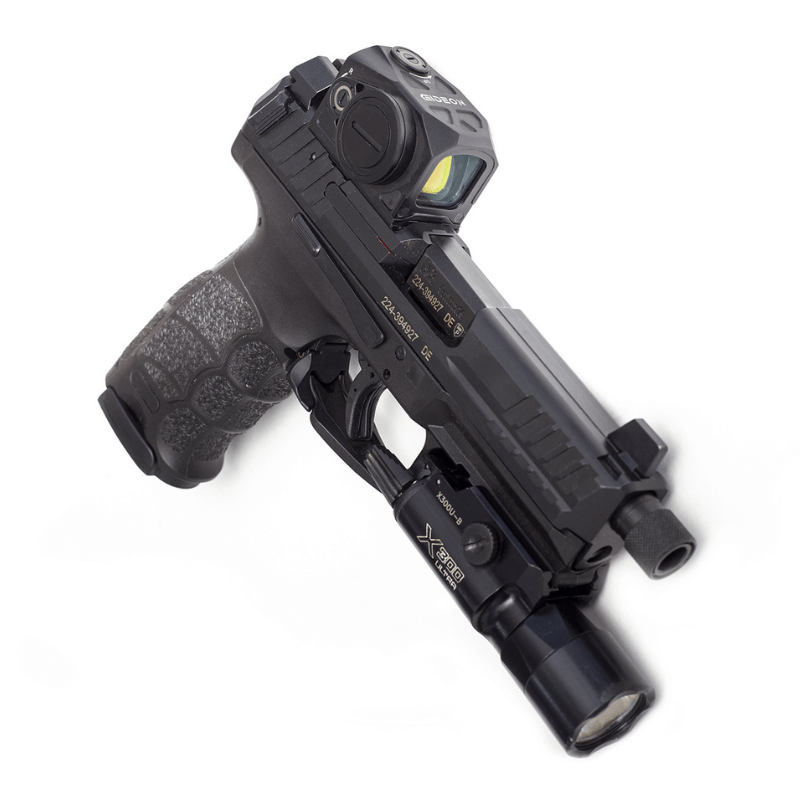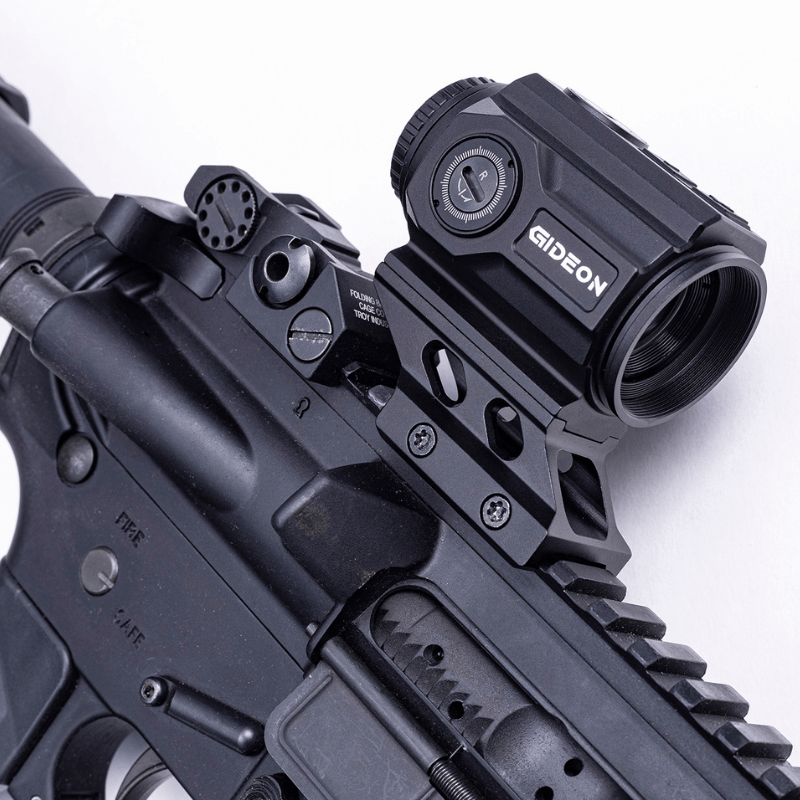
When one of our customers brought up the debate about which is better, red dot vs. prism scopes for carbines, we got excited. That’s not a short answer but rather a whole conversation. Better yet, it gave us a great excuse to get some range time and put together a video about it. We took our two top contenders, the Mediator closed-emitter reflex sight and the Advocate 1X Micro Prism Scope to the range for a little head-to-head action. While both are practical firearms optics suitable for a variety of tactical situations, only one could come out on top.
While both of these are often referred to as red dots due to some key similarities, there are some big differences between how they work and what benefits they bring to the table. On the surface, both are gun optics frequently installed to improve the speed of target acquisition, accuracy, and precision. They both also feature an illuminated reticle that uses a bright, energy-efficient LED emitter to create a prominent aiming tool for your firearm.
The major difference is how they accomplish this job. Red dot optics reflect the LED-generated reticle off a specially coated lens so, as the shooter looks through the lens at the target, a reticle is superimposed on the image. Prism scopes take in the image and reflect it between a series of prisms, one of which has an etched reticle that is also illuminated by the LED emitter. As the shooter looks through the eyepiece of the scope, the image of the target, due to the reflective prisms, has traveled farther than the straight line distance with the reticle being added partway through the process, resulting in an apparent projection of the reticle forward from the optic, reducing the visual planes the shooter is aiming through.
Our original lineup featured both a practically priced closed-emitter red dot sight and an equally budget-friendly micro prism scope: the Mediator and the Advocate, respectively. Despite several exciting new entrants to the closed-emitter market, these were designed as pistol-first options. It seemed only natural to put our two original workhorses to the test.

The Mediator Closed-Emitter Reflex Sight features an Aimpoint ACRO-compatible mounting footprint but comes standard with a 1913 Picatinny riser mount that’s perfect for shotguns and carbines. It features an aircraft aluminum housing, adjustable windage, elevation, and brightness, and a selectable circle-dot reticle in either red or green. It weighs in at a svelte 2.5 ounces and features a 16mm square sight window that offers unlimited eye relief and parallax-free aiming out to 33 yards.
Red dot optics are popular because they’re lightweight, relatively straightforward, and easy to use. Within its parallax range, the reticle is on-target anywhere within the gun’s lens, creating a very forgiving sight for positioning, moving, and rapid transitioning. The primary drawbacks are that the reticle can become lost in bright light if not properly adjusted, and shooters with astigmatism may not see a crisp reticle, introducing more room for variance in their aiming.

The Advocate 1X Micro Prism Scope will mount to any T1/T2 type mount directly or to a 1913 Picatinny rail using the included canted riser. The riser can be stalled in either a forward or rearward canted position to adjust for the most comfortable eye relief. The Advocate uses a tactical triangle-in0circle etched reticle that’s illuminated in either red or green. Windage, elevation, and brightness are all adjustable, and it features a comfortable 85mm eye-relief and is parallax-free to 100 yards.
Prism scopes use their specially ground prisms to reduce the visual planes you’re aiming through, allowing for a more intuitive process/ The etched reticle also means it’s easier for asthmatic shooters to use accurately and will work without illumination or cowitnessing. The more complex lensing system requires a larger body, however, and that adds both size and weight, with the installed advocate and riser weighing eight ounces altogether. Prism scopes also require proper alignment and eye relief, so while a design may be shooter-friendly, it’s not as forgiving as a red dot scope.
Mike hit the range with his trusty SBR, Zelda, and one of each optic to run the red dot vs prism test head-to-head in a drill that required speed, accuracy, and motion. Setting up side-by-side Casino Drill targets, he set up at the 7-yard mark. Seven yards is close enough that he’d have to compensate his aim by drifting the reticle up to hit the casino markers by number in succession, alternating left and right to provide radical movement between shots at the beep. His timer recorded the elapsed time for the initial shot all the way to the final round so we could give our customers some good data points on speed.
Mike ran the targets twice with the Mediator, then followed up with two runs of the Advocate to find a red dot vs. prism winner for carbines in a tactical setting.
| Optic | Mediator Closed-Emitter Reflex Sight | Advocate 1X Micro Prism Scope |
| Fastest First Shot | 1.11 Seconds | 0.90 Seconds |
| Fastest Total Time | 10.67 Seconds | 9.63 Seconds |
With the Advocate, Mike easily outpaced the Mediator, shaving over 10% off his initial shot time and a full second off his best 12-round run. In a follow-up Bill Drill, the Advocate easily kept him lined up and on-target through a six-round rapid-fire burst of shooting as fast as he could pull the trigger. It’s important to note a few things about this challenge, however, and the one uncontrolled variable.
These were Mike’s results, and your mileage may vary. Mike has astigmatism that leaves the Mediator’s reticle slightly blurred but easily useable. This test was also based on Mike’s extensive firearms experience, familiarity with his weapon, and shooting preferences. While the Advocate came out on top of the Mediator when running this red dot vs. prism test, the final numbers were close enough that your own shooting may tip the scales in the other direction.
While we can’t definitively say whether choosing a red dot vs. a prism would be better for you, we can give you plenty of information about each of them to help you make an informed decision. We can also send Mike out to the range–admittedly, that took no convincing–to run the test with real numbers and relate his experiences with them. Hopefully, that’s enough to help out Chris, who got this ball rolling, and anyone else on the fence when it comes to making an optic purchase they’re happy with.
Whichever optic is the best choice for you, we’ll make sure you’re getting a reliable sight picture that’s priced to leave you more money for ammo. Get your carbine ready for action. Order your red dot or prism scope from Gideon Optics today.
🕛 Ends 5/26 at 11:59pm. No code needed. Not valid with other coupons or discounts.